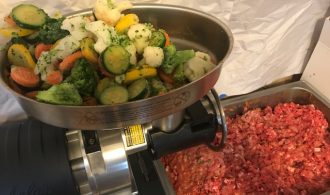Some content may contain affiliate links to products which means we could earn a fee on your purchase. Thank you for visiting
This article is LONG because we are going to dive deep into what it’s like starting an older dog on a homemade raw food.
If your dog isn’t old, that’s okay…you’ll still learn exactly what’s involved in making the switch.
We’re going to cover a lot of ground on this topic so grab your favorite beverage before settling in. These are the things we are going to cover when it comes to starting an older dog on raw food:
- My Best Raw Food for Senior Dogs – 3 Popular Homemade Methods
- Feeding Whole Raw Meaty Bone Method
- Grinding Raw Meaty Bones Method
- Feeding Raw Chunks (no bones) Method
- Which Method is Right for Your Dog?
- Which Method Could Be Harmful to Your Dog?
- Human Pros and Cons of Each Method
- Personal Experiences after Switching to Raw Food
- Tips for Feeding Raw Food
- Feeding Raw Diet on a Budget
- My Raw Dog Food Ratios
- My Raw Dog Food Recipe
Supplies You Might Need – and links to recommendations
- Food Containers – I have these ones
- Food Processor
- Food Grinder – at least 3/4 HP – Only if committed.
- Scale – Battery & Easy to Clean
- Gelato Scoop
- Temperature Gun – link to pricing
DIY: Homemade RAW Dog Food Focus
This article will focus on HOMEMADE Raw and everything involved in the DIY method. If you are looking for a commercially prepared raw dog food that can be shipped to your front door, please read our review here.
Here we go….
Best Raw Food for Senior Dogs – Homemade Methods
There are 3 popular methods when it comes feeding your dog a raw, homemade diet and the method we select has more do to with our dog’s overall health or limitations, than our dog’s actual age.
Some dog owners use just one method while others will use a combination or even all three.
Each method of raw feeding has its own pros and cons. We will review each in detail which will, hopefully, begin to point you in the right direction for starting your older dog on raw food.
Here are the 3 popular methods of feeding dogs a raw, homemade diet.
- Full meaty bones (example: turkey neck or wing)
- Ground meaty bones (think; chicken drumstick through a grinder)
- Meaty chunks (cubes of meat…no bones)
Assuming we are talking about a full raw food diet (not just an occasional supplement), then all of the above would also be accompanied by raw or blanched vegetables that are easy to digest, dog-friendly fruits, and some organ meat.
Combining all of these ingredients ensures we’re making our dog’s primary diet, not merely treats or supplements.
Fillers, Carbs, Extenders
Some owners will add a little cooked white or sweet potato, rice, or peas to extend the food or because their dog needs something that these carbs are offering. That’s the beauty of homemade – it can be designed for your dog’s needs.
Personally, I do not add these to my dog’s raw batch, but my dog will get the occasional carb-rich treat or sweat potato chunks.
Let’s get into more details regarding each method of feeding a raw diet to our dogs.
Method 1: Feeding and Older Dog Raw Full Meaty Bones
Full meaty bones means you are giving your dog a raw piece of bone-in meat. Your selection should be appropriate for your dog’s mouth size. For instance, many owners of small dogs give a poultry wing (whole or portioned) while other dog owners give and entire chicken drumstick or poultry neck.
Alongside their raw, meaty bone, the dog will also get fruits and veggies such as squash, cauliflower, carrot, apple, plus a balanced diet will also offer a bit of organ meat.
A common misconception is that a chicken wing or turkey neck a few times a day is all a dog needs, but a meaty bone alone is not a balanced diet for your dog.
Pros of Feeding Dogs Whole, Raw Meaty Bones
Cleans Teeth: Full raw meaty bones do a decent job of cleaning a dog’s teeth. The chewing of fibrous meat and the occasional scrubbing from the bone visibly improves a dog’s hygiene at the gum line and sometimes you can see before and after that tartar has been removed after eating.
Requires Little Time: Dog owners that use this method have it made in the shade. Some owners will portion out and freeze an entire meal, while other owners will compile a raw meal daily.
Whichever they decide, this method is by far the biggest time-saver because they pretty much feed the raw meat as purchased.
Cons of Feeding Dogs Whole, Raw Meaty Bones
Choke Hazard: Of all the raw food methods, this presents the highest choke hazard. Dog owners who feed this method will tell you that they usually stay in the same room until their dog is finished eating. Even if a dog has been eating this way for years, the possibility of choking on a bone exists every time.
Messy: A whole, raw meaty bone causes extra cleaning. It’s not likely that your dog will chew the bone over his bowl which means: raw meat on the floor. This coupled with all your dog’s saliva makes for a pretty messy meal time and you’ll need to disinfect the area after every meal in order to keep dangerous bacteria from forming.
Allows Selective Eating: Because everything is separate, a picky dog could potentially eat just the meat and skip eating their fruits or veggies, leading to an unbalanced diet.
Is Feeding Whole, Raw Meaty Bones Right for Your Dog
Dogs That Might Do Well Eating Full Meaty Bones: Dogs with good teeth, dogs who actually chew their food (no gulpers), dogs who will eat a fruit or vegetable willingly.
Dogs That Might Suffer From Eating Full Meaty Bones: Dogs who scarf their food, dogs with bad teeth, dogs who suffer mouth pain or have lots of missing teeth, dogs who have difficulty swallowing, dogs with known digestive issues, picky eaters, dogs who are under Dr’s orders to stay away from calcium or phosphorus (plentiful in bones).
If your dog might suffer from eating full meaty bones, or you want to avoid the cons, then perhaps consider method 2 or method 3 of feeding your older dog a raw diet.
Method 2: Feeding an Older Dog Raw, Ground Meaty Bones
This is the method I use 95% of the time for my senior dog. This method means the owner puts whole poultry parts (bone and all) through a meat grinder. The end result looks like hamburger, but contains the bone and all of its nutrients (which my dog needs).
After grinding, I portion the ground meat//bone mixture by weight, freeze it, and then add it (thawed) to other ingredients for every meal, or you can add all the ingredient together (veggies, fruits, organs) and then portion and freeze entire meals.
I follow the 2nd option of mixing all ingredients together and freezing entire meals. My dog is a picky eater and he would leave all of his veggies if I served them whole. This is what my raw dog food looks like with all the ingredients mixed together. This is 2 different varieties that will last about 1 month for my 90lb dog.
I put all ingredients through the grinder and then mix (for what feels like forever) and then portion each meal in stackable, freezer containers. I make enough food for about 3 weeks and freeze it by the meal.
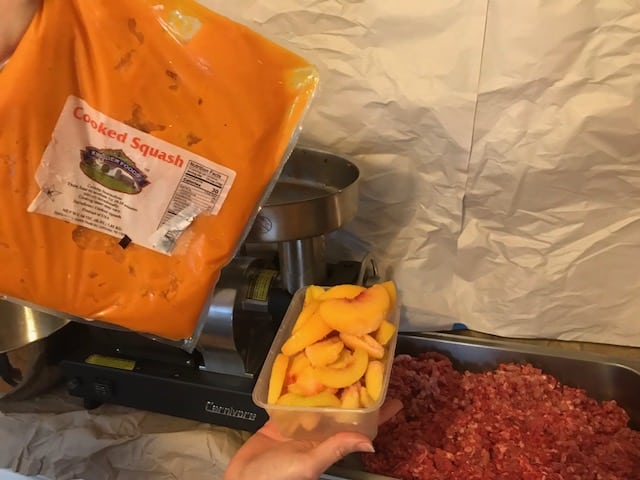
Pros of Grinding Meat
No Choking Hazard: Most grinders come with two grinder screen options so you can control how small the bone will be ground.
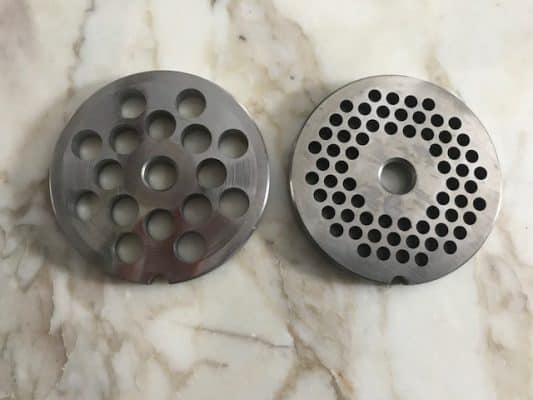
I use the large screen for my huge dog, but I would certainly use the small screen for a small dog.
Versatile: You can do a lot with this ground meat/bone mixture. For instance you can freeze it in tiny clumps for treats, you can use it as an easy pill wrap for easy administering, and you can pour warm liquid over it to make a tasty soup for when your older dog needs a little extra hydration or isn’t drinking.
Pros of Grinding Meat, Veggies, Fruit and Organs all Together into Meals
My Dog Eats Everything: Because this method mixes all ingredients together, it is impossible for my dog to eat around fruits and veggies. He truly eat everything I added, which is important when you’re taking such care in making sure the diet is balanced.
Shop Sale Items: Grinding everything together means the overwhelming taste and flavor is meat…and your dog wants it! If cauliflower happens to be on sale but your dog hates cauliflower, it won’t matter. You can add the cauliflower and your dog will likely not even notice (or mind). My dog will not eat a raw or cooked carrot plain, but has no trouble eating carrots that are sent through the grinder and mixed with his raw meat.
Cons of Grinding Meat
Equipment: In order to adopt this method, you’ll need a meat grinder (link to .75 HP options). Great if you have one but an added expense if you don’t. When I first started making my dog’s raw diet, I was lucky enough to already have a light duty grinder. By light duty I mean a half horsepower or less.
Light duty grinders will definitely work but if you have multiple dogs or large dogs a higher horsepower grinder works much faster and involves far less human assistance. This is a picture of my current 3/4 horsepower grinder:
You’ll see my 3/4 horsepower grinder crush chicken on the next page
Is the Grinding Method Right for Your Dog
Dogs That Might Do Well Eating Ground up Meaty Bones: Dogs with bad or sensitive teeth, dogs who scarf their food, dogs with digestive issues, picky or selective eaters. Dogs who need supplements added to their food (medicine or supplements are very easy to mix into this diet)
Dogs That Might Suffer from Eating Ground up Meaty Bones: Dogs who are under Dr’s. orders to stay away from calcium or phosphorus (plentiful in bones).
If you are not comfortable feeding whole meaty bones; and if you aren’t able to acquire a meat grinder, then it’s time to look at method 3. Plus, if your dog has been placed on a reduced calcium or low phosphorus diet, then method 3 is definitely the option which you’ll want to pursue further.
Method 3: Feeding an Older Dog Raw Meaty Chunks (no bones)
The meaty chunks method is very popular during the introduction stage for both the human and the dog. This method allows you to “get your feet wet” learning what it’s like to feed your older dog a raw diet.
It’s also an easy way to transition your dog from kibble or canned while being able to quickly identify her preferred fruits and vegetables. And if you don’t have a meat grinder, this method is also a very popular option.
What About the Calcium and Phosphorus?
It’s important to note that if this is going to be your preferred method of making raw food, then your dog’s diet will not be balanced because it will be lacking the essential minerals calcium and phosphorus, which are present in the grinding method.
People who feed the raw, chunky meat method do so because their dog
a.) Has been advised to reduce their calcium and phosphorus intake or
b.) Because they are willing to supplement the diet with human grade supplement, bone meal powder
Some pet parents make the mistake of thinking that their dog will get enough calcium if they incorporate broccoli or dark leafy greens into the diet. However, these calcium sources are also rich in oxalic acid, which inhibits calcium absorption and therefore, should not be counted on to deliver a dog’s calcium needs.
Pros of Feeding Raw Meaty Chunks (no bones) to Dogs
Quick: It’s pretty easy to cut up chunks of meat and add fruits, vegetables and organs and then sprinkle with bone meal. It’s equivalent to preparing for a stir-fry, but instead of cooking it for yourself, you feed it to your dog.
Some owners go an extra step and put it through a food processor or blender if their dog has mouth issues or when their dog is prone to eating around fruits and vegetables.
Easy to Chew: As long as you cut pieces the right size for your dog’s mouth, there is very little chance of choking.
Variety: This method makes it easy to offer your dog a huge variety of meats. One night can be beef, another can be chicken or your dog can have lamb night. Essentially, you can make this diet revolve around what the humans are eating and it’s as easy as having an extra person for dinner each night (minus the cooking).
Cons of Feeding Raw Meaty Chunks (no bones)
Absent Minerals: when you remove the bone from the diet, you’re removing critical nutrients such as calcium and phosphorus. You’ll have to make up for these missing nutrients by finding and feeding a quality, US sourced, human grade bone meal powder.
TIP: Never mistake bone meal plant fertilizer with bone meal for humans. You want human supplement bone meal, preferably organic and definitely sourced from US or New Zealand (which has even stricter guidelines for quality). Ask you vet what they would recommend.
Is the Raw Meaty Chunks (No Bone) Method Right for Your Dog
Dogs That Might Do Well Eating Raw Meaty Chunks (No Bone): dogs who have calcium and phosphorus restrictions, dog’s whose parents don’t have a meat grinder, dogs who insist on a constant variety of flavors.
Dogs that Might Suffer from Raw Meaty Chunk (No Bone) Method: Dog’s that need calcium and phosphorus, dogs that already have a calcium or phosphorus deficiency (unless you add the bone meal).
Bottom line is that this method of providing raw meaty chunks is an excellent option for starting raw diets and it’s a viable permanent diet as long as bone meal supplement is added. If you tend to cook healthy lean meat meals for yourself, you and your dog could likely eat a very similar dinner.
Those are the 3 most common methods used by raw dog food feeders. Now let’s review pros and cons of switching to raw food (regardless of method).
Switching to Raw Dog Food Pros & Cons
In this section, I’m going to provide you with the pros and cons that I experienced when first beginning and even now that I’ve been feeding my older dog a raw diet for several years now. It’s important to note that before I switched my senior dog to a full 100% raw food diet, we were buying him the best wet foods and dry foods on the market.
We would mix a little bit of dry with ½ can of wet or sometimes, just all wet food. We made sure to buy no grain, no fillers, high-quality, 3 ingredient type commercial dog foods and it wasn’t cheap.
The final straw for us (and why we decided to begin feeding a raw, homemade diet) was an expensive, incurable, persistent, mysterious skin issue that kept him dosed in harmful steroids coupled with the overwhelming feeling that his health was declining for no good reason
For reference, my older dog is an extra-large breed (90+pounds) German Shepard, Husky, Boxer, Borzoi, Retriever mix. You can read our DNA experience HERE: Is A Dog DNA Test Worth It?
Anyway, he too was an older dog when we began his raw food diet at the age of 10 and we’ve been making homemade raw dog food for a little more than 2 years now.
My now 12 year old senior dog, (which is really old for an extra-large breed) is doing incredible. Here he is getting a clean bill of health during his parvo booster (article link) today:
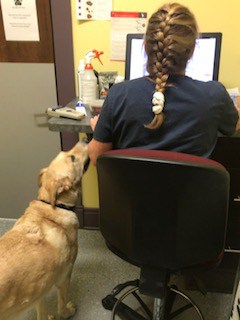
Update: My dog is now 15 years old! This article was written when Frodo was 12 and we are still making his raw dog food every month!
What My Vet Has to Say
The vet and techs agree that his health and mobility is amazing for a 12 year old, extra large breed and I attribute that 100% to the change in his diet from commercial dry and wet, to homemade raw. It’s the best decision I’ve ever made for him.
My primary method is method #2 (I drop full chicken parts, bone and all into a grinder) from there; I also grind all the fruit, vegetable and organs to make a complete mixture.
Here are the pros and cons that I’ve experienced:
Pros
-My Dog lost weight. Frodo went from 118 to 90 pounds, a weight we never thought possible.
-After losing weight, my dog was able to go from laying to standing with far more ease. He has arthritis of the hips and spine and a raw diet compliments his arthritis supplement home regimen.
-My dog lost his “smelly dog” label. Turns out, he wasn’t a stinky dog after all.
-My dog’s skin went from scaly, oily, sporadic thinning with crusty sebum to: pale pink and perfectly cool, normal dog skin.
-My dog’s coat used to be thin on his back hind end area, now it’s as full as everywhere else – this along with krill oil (article) are given credit for the change.
-Persistent yeasty ears cleared and we only clean his ears now once every month or two.
-I saved hundreds on vet bills and my older dog’s health improved in ways I never thought possible. He truly looks like he’s gaining years!
-I don’t have to pay attention to pet food recalls.
-My dog LOVES his food. He gets excited to eat at every single meal. Regardless of flavor combination, he licks his bowl until it looks perfectly clean.
-I cannot remember the last time my dog had diarrhea
Cons
-When I hear that it’s time to make dog food, my initial response is pfffffffffffffttttt! We make 50-60 pounds of dog food at a time and Frodo goes through it in about a month.
Five months ago, we upgraded our grinder from a 1/2 horsepower to a 3/4 and the difference is AMAZING! You can watch my 3/4 horsepower grinder take on chicken bones in this short video:
Upgrading to a 3/4 horsepower grinder (product link) has cut our time in half as it really eats up chicken legs and thighs like they’re nothing.
It used to take us about 3 hours to make 30 pounds with the small grinder, but now it takes about 2 hours (cleanup included) to make twice as much: 60 pounds.
-Lots of extra dishes. Because we freeze his food, that’s 2 freezer containers per day. We don’t feed him out of the freezer containers. We put his meal into a glass dish each time so that’s another 2 bowls per day. Here is a picture of his food for the day:
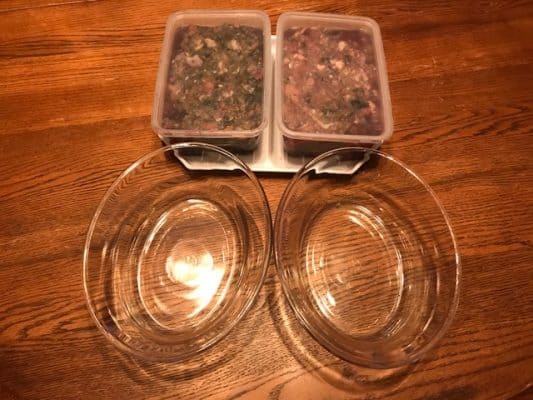
-You have to commit to being diligent with cleaning. We’ve never had a problem with bacteria or contamination but we are hyper-sanitizers. During dog food production, I protect my counters and cabinets with newspapers and throw everything away after. After production, everything (grinder, trays, cabinets, drawer handles, etc.) is Lysoled to oblivion.
-Travel takes more planning. We’ve got it down to a science now, but you’ll need a cooler to transport raw food around and once you’ve made it to your destination, you’ll need a fridge. If you’re going on long road trips consider a cooler that plugs into your car’s lighter outlet like this: Long Road Trip Cooler (product link). Because stopping for ice gets rather inconvenient.
Those are the immediate pros and cons that come to mind. Since our experience has been nothing short of amazing, the cons are easily accepted and I’d never consider making my life easier by going back to company manufactured dog food offerings.
Now here are some tips for starting an older dog on raw food
Tips for Feeding Raw Diet to an Older Dog (Regardless of Method)
-Don’t feed COLD or Frozen raw food to a dog. You can use the defrost feature on your microwave to slightly warm raw food without cooking it.
Even though the diet is fed as raw, your dog may not be able to tolerate it cold (refrigerator cold). My dog will regurgitate his raw diet unless it’s between 85-100°F. Trust me, cleaning up raw dog food vomit is not something you want to do: warm the food!
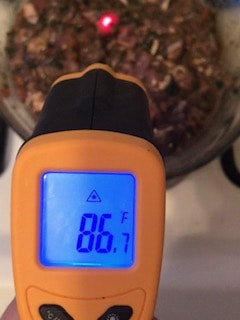
-To avoid having to stick your finger in raw meat to test the temperature, these laser thermometers are affordable and probably my favorite kitchen gadget and you can find this exact model on amazon here: Infrared Laser Thermometer
-Never cook raw bones and then feed them to your dog. Cooked bones change in their composition, becoming less flexible and more brittle. Cooked, heated bones can do serious damage to your dog.
-Watch your dog’s feces closely. If you’ve incorporated carrots and all the carrots are visible, then maybe you should swap carrots for something your dog will digest easier. The proof will be in the “poo”ding.
-Transition slowly by feeding a chunk of raw meat daily.
-Variety helps to ensure your dog is getting vital nutrients and vitamins. Swap dog-friendly ingredients regularly.
-Blanche veggies that are not easy to digest such as broccoli and cauliflower or buy them frozen but already cooked.
-If you decide that you’re going to commit to feeding your dog a raw food diet using the grinding method, investing in a higher end grinder will make your life so much easier; especially if your dog is large and eats a lot or you have multiple dogs.
This LEM Grinder (product pricing and info link) comes in 5 different Horsepower models. The .50 (1/2 horsepower) is the minimum you should consider. It will do the job but it will require you to use the plunger and drive the chicken down the chute.
If you’d rather just “drop” the chicken and only deal with the occasional plunging, then and I highly recommend the .75 (3/4 horsepower) you really don’t need the 1 or 1.5 horsepower unless you really want it!
-If you’re going to make large quantities and freeze, get stackable freezer containers that are all the same size (they slightly nest into each other). I purchased a pack of 50 about 2 years ago and they are holding up great. Trust me: zipper bags leak and leaky raw dog food is a no-no.
-Don’t hide the fact that you’re feeding your dog a raw diet. Share it with your vet; share it with friends, family and co-workers when asked. Although none of my vets have ever offered assistance with meal balancing, they all seemed happy to hear that he was eating raw food. Bottom line, his health and blood work do the talking.
Feeding Raw Diet on a Budget
Many people assume that a homemade raw diet is cost prohibitive, but it doesn’t have to be. If you’re already buying high quality, commercially available dry or canned dog food, your budget will not change much if you shop wisely.
- Buy frozen ingredients whenever they are on sale and stockpile them.
- Buy frozen fruits and vegetables in bulk stores and definitely use you own, home-grown.
- Take advantage of regional bumper crops. Squash is abundant in the fall and most dogs like zucchini, yellow squash and pumpkin. Farmers markets often sell huge bushels of apples at a steep discount during apple season. Pay attention to your local offerings and buy the excess.
- If you have to extend the raw diet with an inexpensive carbohydrate, use non-wheat items like potato, sweet potato, rice or pea. Be careful though because some dogs cannot tolerate peas or potato – most owners will try it in small amounts and see how their dog responds.
My Raw Dog Food Recipe and Ratios
Most dog owners who feed a raw diet like to switch things up by offering different flavor blends. I switch between turkey and chicken or sometimes a blend of both. I like to get half skinless and half skin on. If all I can find is skin-on, I make sure to remove the skin on half of the meet simply because I don’t want my dog having too much fat.
I reserve raw beef feeding for special treats and I make sure it’s a quality beef, not pre-ground.
For vegetables, in this recipe I use cabbage, carrots, broccoli, cauliflower, celery, peppers, squash (all types), spinach, kale or brussel sprouts. Pick one or two.
For fruits in this recipe, I use strawberries, blueberries, mango, apples, peaches, mixed berry blends and pears. Pick one or two.
This is my dog’s basic go-to formula and you are welcome to use this as a starting point for your new journey. Consider your own dog’s needs and adjust as needed.
The raw food diet ratio I feed my dog is this:
- 60% Bone in Meat
- 25% Vegetables and Fruits
- 15% Organ Meat
So if I were going to make 10 pounds of raw dog food my ingredients would look like this:
- 6 pounds bone in meat (50/50 mix of chicken thigh & drumstick- ½ skinless)
- 2.5 pounds of fruits and vegetables (50/50 mixed blend or slightly more vegetables)
- 1.5 pounds of organ meat mix (gizzard blend & liver) I never use just liver.
I make about 60 pounds at a time, so my ingredients look like this:
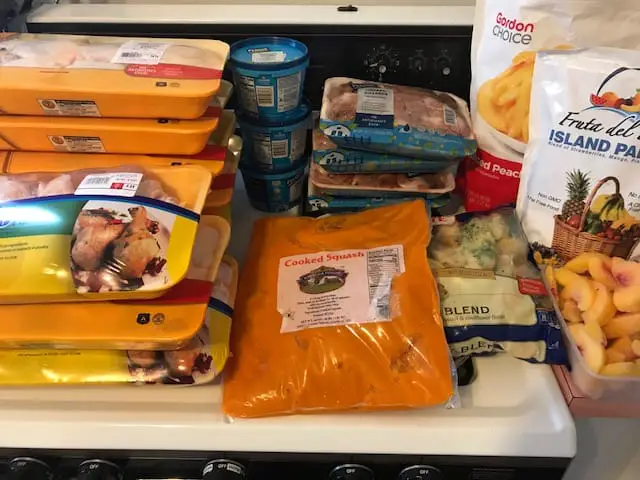
Using Method #2, the grinding method, I would put all of these ingredients through my grinder when they are just beginning to thaw. This ensures they stay nice and cold throughout the process.
I send meats through the grinder first, followed by fruits and vegetables (because I’d rather clean residual fruits and vegetable parts from the grinder than bone and gizzards). But that’s just me.

I mix everything thoroughly and depending on consistency I might need to add some water. I like it thick, but movable. Wetter than a meatloaf batter – it should just release from a spoon. To see the consistency of my dog’s raw diet, watch this 9 second video:
Using a kitchen scale like this one: digital scale link
I weigh out my dog’s portions in these freezer containers from amazon. I like them because they stack into each other and are BPA free. He eats about 18-20 ounces twice per day.

Freeze at once.
Summarizing the Raw Food Dog Diet Movement
Starting an older dog on a raw diet could turn out to be an absolute blessing or a logistical nightmare. Each person is different and will have various amounts of time to commit to ensuring the proper balance.
Each dog is different, but for us, the raw diet journey has been the best decision we’ve ever made for our senior dog. He smiles while his food is being prepared, he leaves no trace behind, and his overall health and weight is finally in our hands.
While many veterinarians seem slow to participate, they are out there! Plus you can find plenty of people leading the charge and reporting similarly amazing results.
I hope you’ve found my experience helpful and that you are one step closer to making a decision.
Thanks for spending time at seniordogdays.com!

